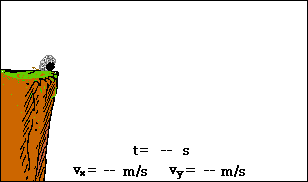
Non-Horizontally
Launched Projectiles
A GIF Animation
Imagine a cannonball being launched at an angle from a cannon
atop of a very high cliff. Imagine as well that the cannonball does
not encounter a significant amount of air resistance. What will be
the path of the cannonball and how can the motion of the cannonball
be described? The animation below depicts such a situation. The path
of the cannonball is shown; additionally, the horizontal and vertical
velocity components are represented by arrows in the animation.

As can be seen from the above animation, the cannonball
follows a parabolic path. As the cannonball rises towards its peak,
it undergoes a downward acceleration. An upwardly moving cannonball
which is slowing down is said to be undergoing a downward
acceleration. As the cannonball falls, it undergoes a downward
acceleration. A downwardly-moving cannonball which is gaining speed
is said to have a downward acceleration. In the animation, the
downward acceleration is depicted by a change in the vertical
component of velocity. This downward acceleration is attributed to
the downward force of gravity which acts upon the ball. If the ball's
motion can be approximated as projectile motion (that is, if the
influence of air resistance can be assumed negligible), then there
will be no horizontal acceleration. In the absence of horizontal
forces, there would be a constant velocity in the horizontal
direction. In the animation, this is depicted by the fact that the
horizontal velocity component remains the same size throughout the
entire motion of the cannonball.
Many would insist that there is a horizontal force acting upon
the cannonball since it is moving horizontally. Yet this is simply
not the case. The horizontal motion of the cannonball is the result
of its own inertia. When launched from the cannon, the cannonball
already possessed a horizontal motion, and thus will maintain this
state of horizontal motion unless acted upon by a horizontal force.
An object in motion will continue in motion with the same speed and
in the same direction ... (Newton's first law). Remind your self
continuously: forces are not required for an object to be moving;
once in motion, the presence of forces will only serve to accelerate
such objects.
For more information on physical descriptions of motion,
visit
The
Physics Classroom. Specific information is available there on the
following topics:
This page was created by
Tom
Henderson of
Glenbrook South
High School.
Comments and suggestions can be sent by e-mail to
Tom
Henderson.
A hearty thanks is due to lab assistant Bryce Mautner for her
assistance with the graphics and GIF animation.
This page last updated on 3/17/97.
